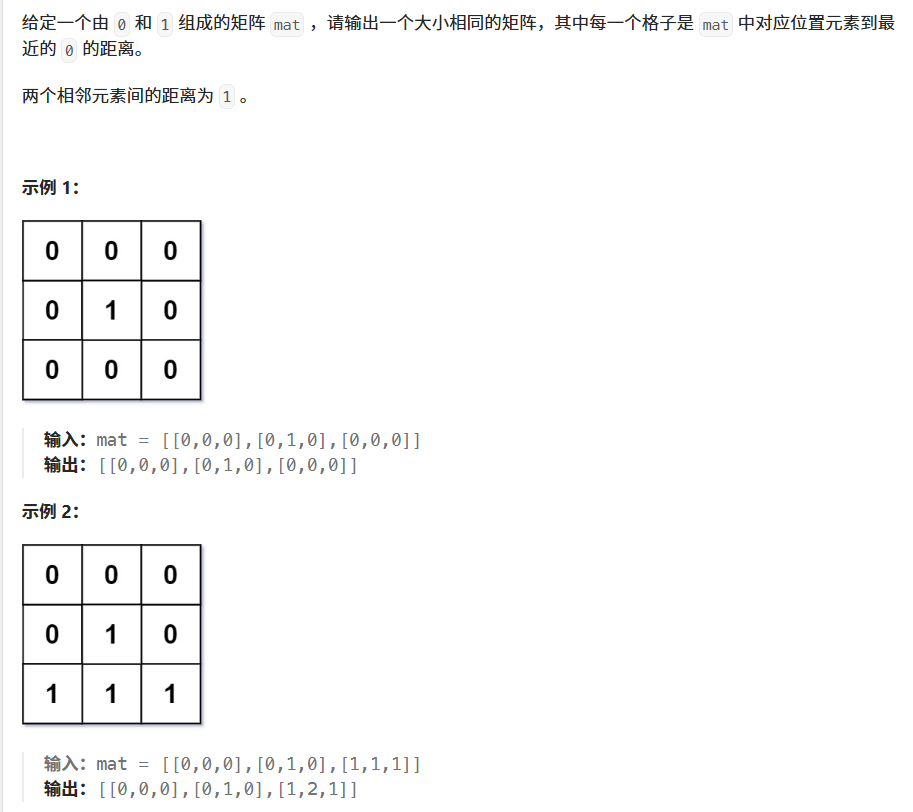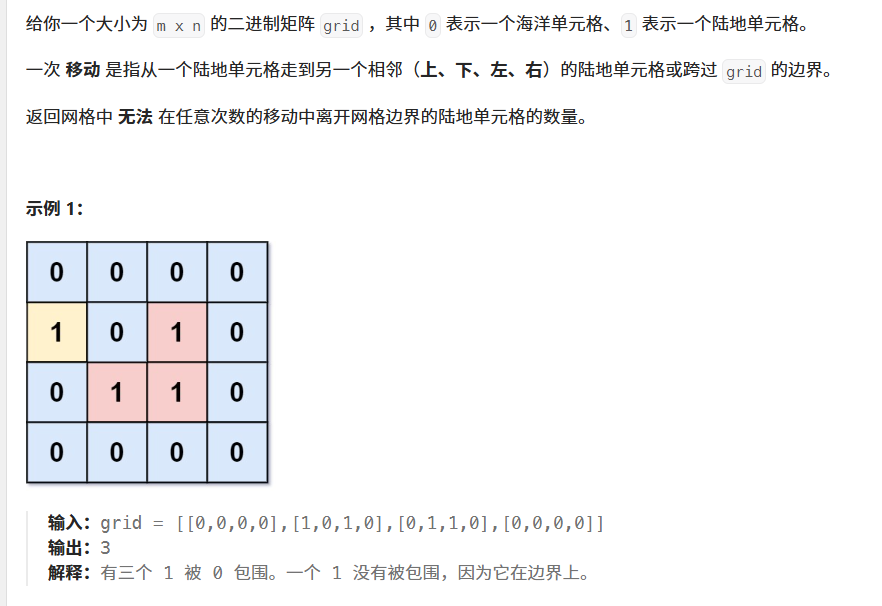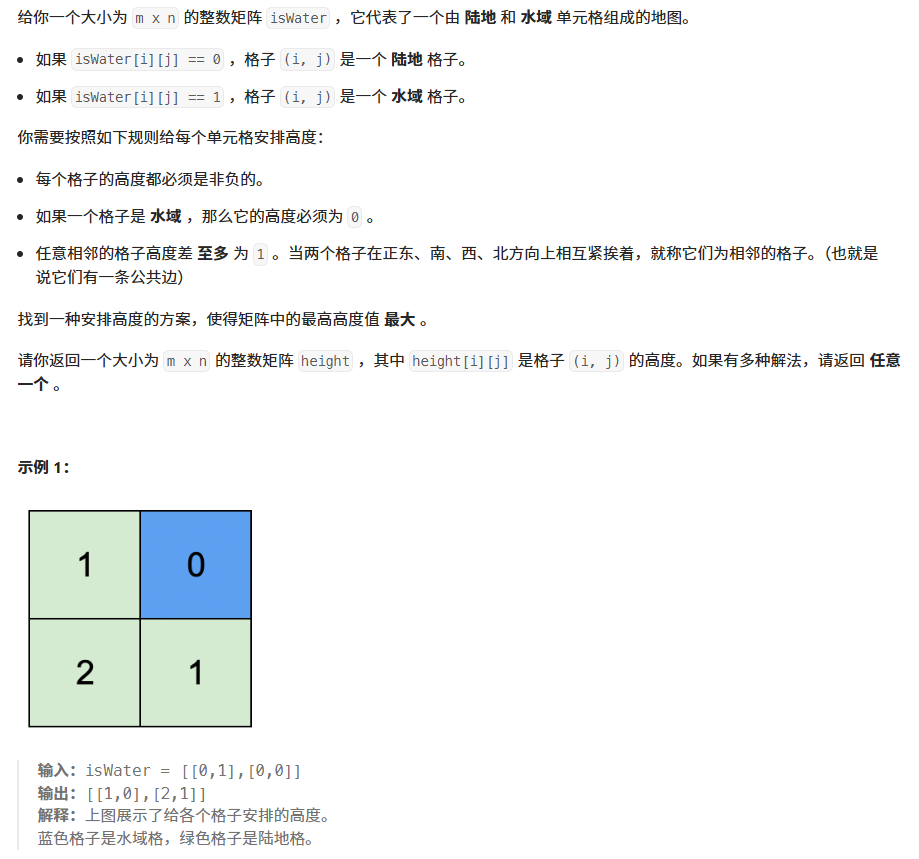📝前言说明:
- 本专栏主要记录本人的基础算法学习以及LeetCode刷题记录,按专题划分
- 每题主要记录:(1)本人解法 + 本人屎山代码;(2)优质解法 + 优质代码;(3)精益求精,更好的解法和独特的思想(如果有的话)
- 文章中的理解仅为个人理解。如有错误,感谢纠错
🎬个人简介:努力学习ing
📋本专栏:C++刷题专栏
📋其他专栏:C语言入门基础,python入门基础,C++学习笔记,Linux
🎀CSDN主页 愚润泽
你可以点击下方链接,进行该专题内不同子专题的学习
| 点击链接 | 开始学习 |
|---|---|
| 双指针(1) | 双指针(2) |
| 双指针(3) | 双指针(4) |
| 滑动窗口(1) | 滑动窗口(2) |
| 滑动窗口(3) | 滑动窗口(4) |
| 二分查找(1) | 二分查找(2) |
| 前缀和(1) | 前缀和(2) |
| 前缀和(3) | 位运算(1) |
| 位运算(2) | 模拟算法 |
| 快速排序 | 归并排序 |
| 链表 | 哈希表 |
| 字符串 | 栈 |
| 队列 + 宽搜 | 优先级队列 |
| BFS 解决 FloodFill | BFS 解决最短路径 |
| 多源 BFS | BFS 解决拓扑排序 |
题单汇总链接:点击 → 题单汇总(暂时未整理,因为还没刷完)
导论——多源 BFS
多元最短路问题:起始点有多个,去同一个终点
- 前提:BFS解决的最短路问题都是边权为 1 的
- 解法一:把多源最短路问题转换成若干个单源最短路问题——暴力枚举每个起点,对每个起点进行单源最短路问题分析【但是时间复杂度高:超时】
- 解法二:把所有的源点当成一个“超级源点”——从“超级源点”出发,一次单源最短路问题
- 如何求:“超级源点” ?
- 把所有的起始节点加入到队列中,即:第一层由单源的一个节点变成了多源的多个节点(只不过这些节点都属于第一层罢了)
- 多个源点可能开辟出不同的路,在不同的路中:后到达的节点会被
hash淘汰
542. 01 矩阵
题目链接:https://leetcode.cn/problems/01-matrix/description/

优质解
思路:
- 解法一:把 1 当成起点的话,要遍历整个矩阵
- 解法二:把 0 当起点:
从所有 0 走到某一个 1 的最短距离 == 从 1 走到最近 0 的距离
代码:
class Solution {
public:
vector<vector<int>> updateMatrix(vector<vector<int>>& mat)
{
int dx[4] = {0, 0, 1, -1};
int dy[4] = {1, -1, 0, 0};
int m = mat.size(), n = mat[0].size();
queue<pair<int, int>> q;
vector<vector<int>> dis(m, vector<int>(n, -1));
// 先获得"超级源点"
for(int i = 0 ; i < m; i++)
{
for(int j = 0; j < n; j++)
{
if(mat[i][j] == 0)
{
q.push({i, j});
dis[i][j] = 0;
}
}
}
// 从"超级源点"开始扩展
while(q.size())
{
// int sz = q.size(); 为什么可以不计算 sz ?
// 因为之前的 sz 是和 step 配合使用的,我们通过sz知道是在哪一层
// 但是现在,下一个dis中填写的内容可以根据上一个dis中的内容决定
// 并且,一定是上一层的节点pop出去以后,才会处理上一层加入的后续节点
auto [a, b] = q.front();
q.pop();
for(int j = 0; j < 4; j++)
{
int x = a + dx[j], y = b + dy[j];
if(x >= 0 && x < m && y >= 0 && y < n && dis[x][y] == -1)
{
dis[x][y] = dis[a][b] + 1;
q.push({x, y});
}
}
}
return dis;
}
};
时间复杂度: O ( m ∗ n ) O(m*n) O(m∗n)
空间复杂度: O ( m ∗ n ) O(m*n) O(m∗n)
1020. 飞地的数量
题目链接:https://leetcode.cn/problems/number-of-enclaves/description/

个人解
屎山代码:
class Solution {
public:
int numEnclaves(vector<vector<int>>& grid)
{
// 这就是 floodfill
// 只不过从边缘 1 开始先标记连通块的时候可以使用 多源 bfs 标记
int dx[4] = {0, 0, 1, -1};
int dy[4] = {1, -1, 0, 0};
int m = grid.size(), n = grid[0].size();
queue<pair<int, int>> q;
for(int i = 0; i < m; i++)
{
for(int j = 0; j < n; j++)
{
if((i == 0 || i == m - 1 || j == 0 || j == n - 1) && grid[i][j])
{
grid[i][j] = 0;
q.push({i, j});
}
}
}
while(q.size())
{
auto [a, b] = q.front();
q.pop();
for(int i = 0; i < 4; i++)
{
int x = a + dx[i], y = b + dy[i];
if(x >= 0 && x < m && y >= 0 && y < n && grid[x][y])
{
grid[x][y] = 0;
q.push({x, y});
}
}
}
int ans = 0;
for(int i = 0; i < m; i++)
{
for(int j = 0; j < n; j++)
{
if(grid[i][j])
ans++;
}
}
return ans;
}
};
时间复杂度: O ( m ∗ n ) O(m*n) O(m∗n)
空间复杂度: O ( m ∗ n ) O(m*n) O(m∗n)
1765. 地图中的最高点
题目链接:https://leetcode.cn/problems/map-of-highest-peak/description/

个人解
思路:
- 和 01 矩阵一样
屎山代码:
class Solution {
public:
vector<vector<int>> highestPeak(vector<vector<int>>& isWater)
{
// 自行安排出最高高度
// 以水域为起点,能到达的最远的陆地最高(走最短路径)
int dx[4] = {0, 0, 1, -1};
int dy[4] = {1, -1, 0, 0};
int m = isWater.size(), n = isWater[0].size();
vector<vector<int>> high(m, vector<int>(n, -1));
queue<pair<int, int>> q;
for(int i = 0; i < m; i++)
{
for(int j = 0; j < n; j++)
{
if(isWater[i][j])
{
q.push({i, j});
high[i][j] = 0;
}
}
}
while(q.size())
{
auto [a, b] = q.front();
q.pop();
for(int i = 0; i < 4; i++)
{
int x = a + dx[i], y = b + dy[i];
if(x >= 0 && x < m && y >= 0 && y < n && high[x][y] == -1)
{
high[x][y] = high[a][b] + 1;
q.push({x, y});
}
}
}
return high;
}
};
时间复杂度: O ( m ∗ n ) O(m*n) O(m∗n)
空间复杂度: O ( m ∗ n ) O(m*n) O(m∗n)
1162. 地图分析
题目链接:https://leetcode.cn/problems/as-far-from-land-as-possible/description/

个人解
思路:
// 海洋到最近的陆地的距离 == 陆地到海洋的最短路径
// 以陆地为起始点做 bfs
用时:14:00
屎山代码:
class Solution {
public:
int maxDistance(vector<vector<int>>& grid)
{
int dx[4] = {0, 0, 1, -1};
int dy[4] = {1, -1, 0, 0};
int m = grid.size(), n = grid[0].size();
queue<pair<int, int>> q;
for(int i = 0; i < m; i++)
{
for(int j = 0; j < n; j++)
{
if(grid[i][j])
q.push({i, j});
}
}
int ans = 0;
while(q.size())
{
auto [a, b] = q.front();
q.pop();
for(int i = 0; i < 4; i++)
{
int x = a + dx[i], y = b + dy[i];
if(x >= 0 && x < m && y >= 0 && y < n && !grid[x][y])
{
grid[x][y] = grid[a][b] + 1;
ans = max(ans, grid[x][y]);
q.push({x, y});
}
}
}
return ans - 1; // 因为第一次是 1 -> 2,但其实是 1
}
};
时间复杂度: O ( m ∗ n ) O(m*n) O(m∗n)
空间复杂度: O ( m ∗ n ) O(m*n) O(m∗n)
🌈我的分享也就到此结束啦🌈
要是我的分享也能对你的学习起到帮助,那简直是太酷啦!
若有不足,还请大家多多指正,我们一起学习交流!
📢公主,王子:点赞👍→收藏⭐→关注🔍
感谢大家的观看和支持!祝大家都能得偿所愿,天天开心!!!